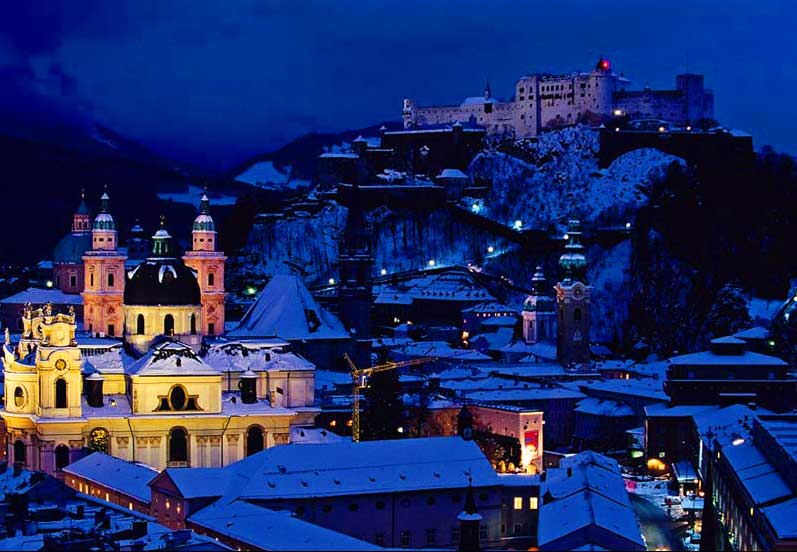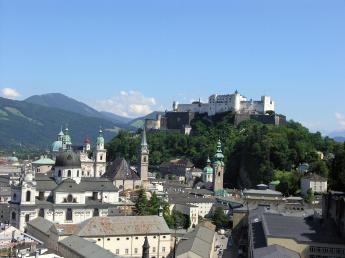The City of Salzburg is the capital of the
federal state Salzburg in Austria.
The Festung or Hohensalzburg Fortress overlooks
the great Cathedral in the middle of the Old City.


History
The first settlements at Salzburg were apparently
begun by the Celts.
Around 15 BC the separate settlements were merged into one city by the
Romans.
At this time the city was called Juvavum and was awarded the status of a
Roman
municipium in 45 AD. Around this time, first records of Jewish settlers
appear.
Juvavum developed into an important town of the
Roman province of
Noricum. A
Roman Catholic
diocese was
formed in the town around 700, which later became an archdiocese responsible for
Bavaria.
The economic wealth of the town during this time
was based on
salt-mining. Salz is the German word for salt, making the name
literally mean "Salt castle". A variant English form of the name is 'Saltsburg'.
The town's river was a main artery for transporting salt mined in nearby
mountains.
In 1077 the fortress
was constructed under the order of Duke Gebhard.
In the late 15th century the Jews were expelled
from the town.
Until 1803, the
Archbishop of Salzburg was the ruler of the city and the surrounding
territory. Successive archbishop princes moulded the town, with the most
influential being
Wolf Dietrich who was largely responsible for the shape of the city today.
His influence saw the creation of the towering Salzburg cathedral, the
Mirabell Garden, and other landmarks. In 1803, Salzburg became politically a
part of Austria, and so it remains to this day.
Not all of these Archbishop-Princes left a noble
legacy. On October 31, 1731, the 214th Anniversary of
Martin Luther's launching the
Reformation by nailing his
95 Theses
of Contention to the
Wittenberg
Church door,
Roman Catholic Archbishop Count
Leopold von Firmian signed his Edict of Expulsion (not to be confused with
many similar edicts of expulsion issued against the
Jews in various
cities in Europe),
the Emigrationspatent, declaring that all
Protestants recant their non-Catholic beliefs or be banished.
After signing the edict on the 214th Anniversary
of Reformation Day, Archbishop von Firmian declared that it was to be read
publicly November 11, 1731, the 248th anniversary of Luther's baptism. Believing
that his edict would drive away a few hundred troublesome infidels in the hills
around the town, Firmian was surprised when 21,475 citizens professed on a
public list their Protestant beliefs.
Land owners were given three months to sell their
lands and leave. Cattle, sheep, furniture and land all had to be dumped on the
market, and the Salzburgers received little money from the well-to-do Catholic
allies of Von Firmian. Von Firmian himself confiscated much of their land for
his own family, and ordered all Protestant books and Bibles burned. Many
children aged 12 and under were seized to be raised as Roman Catholics. Yet
those who owned land gained one key advantage: the three month deadline delayed
their departure until after the worst of winter.
Non-owner farmers, tradesmen, laborers and miners
were given only 8 days to sell what they could and leave. The first refugees
marched north through the
Alps in desperately
cold temperatures and snow storms, seeking shelter in the few cities of Germany
controlled by Protestant Princes, while their children walked or rode on wooden
wagons loaded with baggage.
As they went, the exiles' savings were quickly
drained away as they were set upon by both legal and illegal highwaymen, who
seized taxes, tolls and payment for protection by soldiers from robbers.
The story of their plight spread quickly as their
columns marched north. Goethe wrote the poem Hermann and Dorothea about
the Salzburg exiles' march. Protestants and even some Catholics were horrified
at the cruelty of their expulsion in winter, and the courage they had shown by
not renouncing their faith. Slowly at first, they came upon towns that welcomed
them and offered them aid. But there was no place where such a large number of
refugees could settle.
Finally, in 1732 Lutheran King
Frederick William I of Prussia accepted 12,000 Salzburger Protestant
emigrants, who settled in areas of
East
Prussia that had been devastated by the
plague twenty
years before. Their new homelands were located in what today is northeastern
Poland, the
Kaliningrad Oblast, and
Lithuania.
Other, smaller groups made their way to the
Banat region of
modern Romania,
to what is now
Slovakia, to areas near
Berlin and
Hannover in
Germany, and to the
Netherlands.
On March 12, 1734, a small group of about sixty
exiles from Salzburg who had traveled to London arrived
in the British American colony of
Georgia seeking religious freedom. Later in that year they were joined by a
second group, and by 1741 a total of approximately 150 of the Salzburg exiles
had founded the town of
Ebenezer on the
Savannah River, about twenty five miles north of the city of Savannah.
Other German speaking families – mostly Swiss Germans, Palatines and Swabians –
also joined the Salzburgers at Ebenezer. In time, all of these Germanic people
became known as "Salzburgers"
During World War II, the city was lucky not to
sustain heavy damage from Allied bombing runs. Although the town's bridges and
the dome of the cathedral were demolished, much of its baroque architecture
remained intact. As a result, it is one of the few remaining examples of a town
of its style.
In the city of Salzburg there were several
DP Camps
following World War II. Among these were
Riedenburg,
Camp Herzl (Franz-Josefs-Kaserne),
Camp Mülln,
Bet Bialik,
Bet Trumpeldor,
New Palestine.
In 1965, the movie
The Sound of Music was filmed in Salzburg and
the state of Salzburg. The movie was based on the true story of
Maria von Trapp, a Salzburg-based nun who took up with an aristocratic
family and fled German occupation. Although the film is relatively unknown to
Austrians, the town draws a large percentage of visitors who wish to relive the
movie by visiting the filming locations.
In 1996 the City of Salzburg was defined by a
World Heritage Site.
Notable citizens
- The famous composer
Wolfgang Amadeus Mozart was born and raised in Salzburg. His house of
birth and residence are popular tourist attractions. His family is buried in a
small church graveyard in the old town, and there are many monuments to
"Wolferl" in the city.
-
Christian Doppler, an expert on
acoustic
theory, was born in Salzburg. He is most renowned for his discovery of the
Doppler effect.
-
Josef
Mohr was born in Salzburg. Together with
Franz
Gruber, he composed and wrote the text for
Silent Night. As a priest in neighbouring
Oberndorf
he performed the song for the first time in 1818.
- Noted writer
Stefan Zweig resided in Salzburg for about 15 years until his departure in 1934.
- Salzburg is also the birthplace of
Hans
Makart, a
19th
century Austrian painter-decorator and national celebrity. Makartplatz (Makart
Square) is named in his honour.
-
Writer
Thomas Bernhard was raised in Salzburg and spent part of his life there.
-
Herbert von Karajan was a notable musician and conductor. He was born in
Salzburg and died in 1989 in neighbouring
Anif.
Tourist Informations you can get
here.
Try to find the Salzburger Dom at N 47°47.879,
E 013° 02.761 and take a picture with you and the cathedral for your log. If you
like you can also choose another point of interest. You will find enough during
your sightseeing tour trough this City.
Happy waymarking
Ras Tafari